Mi'kmaq
The Family
The Mi'kmaq (lit. "The Family") are one of two Native American Tribes of the First Nations that have settled Eydraumr, the other being the Abenaki. The Mi'kmaq people are considered to be a tribe contained within the greater Abenaki group as the Eastern Abenaki tribes of the Wabanaki Confederacy (Wapnáki) include the Mi'kmaq, Maliseet, Passamaquoddy, and Penobscot. The Mi'kmaq have also been referred to as the Micmac, the Migmaw, Migmao, Mi'gmaq, and Mìgmaq. The term Micmac is shunned by the Mi'kmaq, as the term was heavily utilized during colonial periods and interactions. Mi'kmaq, or its singular/adjective Mi'kmaw, is used by outsiders. The Mi'kmaq refer to themselves as Lnu (plural Lnúk), meaning "human" or "person."
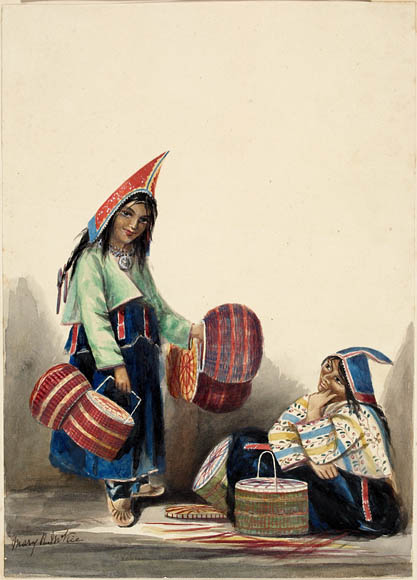 The Mi'kmaq traditionally had a subsistence-based lifestyle, with fishing, hunting, gathering, and agriculture done in accordance with tradition and a heavy value placed on the reciprocal relationship forged between the tribe and the land. The Mi'kmaq had a heavy naval presence, with a vast network of canoe networks along the North-Eastern Atlantic coast. The primary resources available for use and trade varied depending on the season, as movement and activity primarily focused on whatever resource was most plentiful. Every part of an animal was used, if possible.
With the arrival of Europeans, a heavier focus on gathering goods for trade, such as furs and bone, developed among the Mi'kmaq. Non-migratory animals increased awareness of territoriality within Mi'kmaq society, which drove the Mi'kmaq to consolidate into larger bands to establish ownership of lands and resources. Dry-curing methods were learned from the Europeans. Trade primarily focused on furs, food, and the finely crafted weapons produced from maple woods, bone, and horns.
In more modern times, The Mi'kmaq are considered to be the inventors and expert craftsmen of the hockey stick.
The Mi'kmaq traditionally had a subsistence-based lifestyle, with fishing, hunting, gathering, and agriculture done in accordance with tradition and a heavy value placed on the reciprocal relationship forged between the tribe and the land. The Mi'kmaq had a heavy naval presence, with a vast network of canoe networks along the North-Eastern Atlantic coast. The primary resources available for use and trade varied depending on the season, as movement and activity primarily focused on whatever resource was most plentiful. Every part of an animal was used, if possible.
With the arrival of Europeans, a heavier focus on gathering goods for trade, such as furs and bone, developed among the Mi'kmaq. Non-migratory animals increased awareness of territoriality within Mi'kmaq society, which drove the Mi'kmaq to consolidate into larger bands to establish ownership of lands and resources. Dry-curing methods were learned from the Europeans. Trade primarily focused on furs, food, and the finely crafted weapons produced from maple woods, bone, and horns.
In more modern times, The Mi'kmaq are considered to be the inventors and expert craftsmen of the hockey stick.
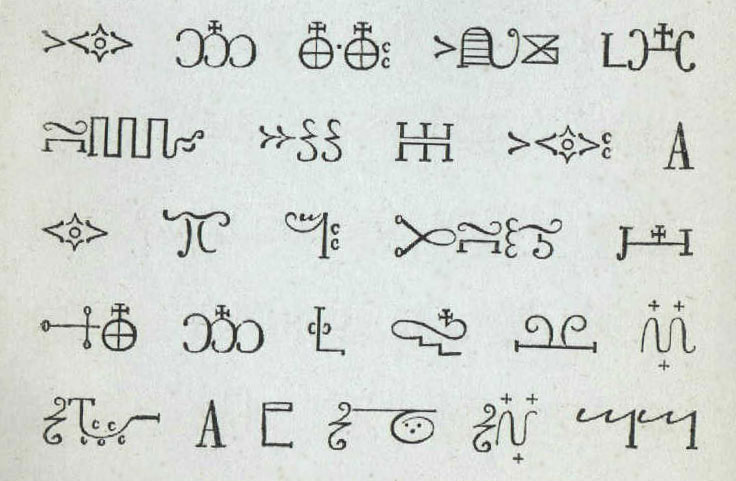 Mi'kmaq is a distinct Algonquin language, with approximately 4 percent of modern Mi'kmaq considered speakers of the language. Modern Mi'kmaq use the Latin alphabet, while the language previously held its own hieroglyphic alphabet. Many surviving records of this hieroglyphic alphabet were found in the belongings of Christian ministers, who would have their prayers and stories transcribed into Mi'kmaq for use in their proselytizing. There have been a large number of etchings and paintings recovered in caves and other areas throughout historic Mi'kmaq lands; linguistic analysis has shown that the traditional hieroglyphic writing system was a fully-functional system, making it the oldest writing system for a native language North of Mexico.
Mi'kmaq is a distinct Algonquin language, with approximately 4 percent of modern Mi'kmaq considered speakers of the language. Modern Mi'kmaq use the Latin alphabet, while the language previously held its own hieroglyphic alphabet. Many surviving records of this hieroglyphic alphabet were found in the belongings of Christian ministers, who would have their prayers and stories transcribed into Mi'kmaq for use in their proselytizing. There have been a large number of etchings and paintings recovered in caves and other areas throughout historic Mi'kmaq lands; linguistic analysis has shown that the traditional hieroglyphic writing system was a fully-functional system, making it the oldest writing system for a native language North of Mexico.
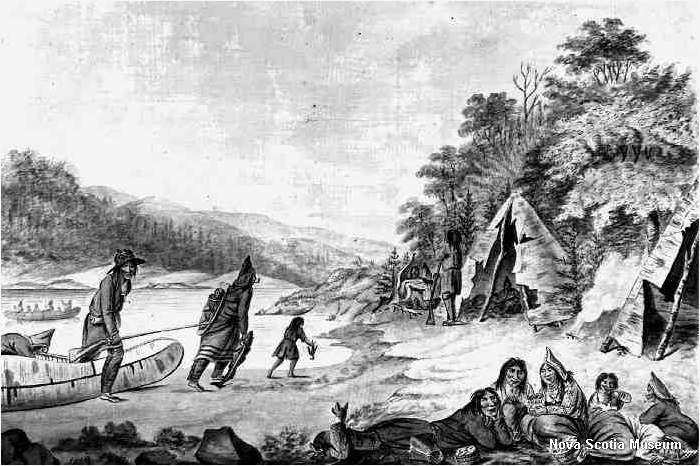 As the climate was relatively unfavorable for agricultural activities, hunting and fishing took a greater focus in daily life. The Mi'kmaq lived in scattered semi-nomadic inland communities during the winter, with larger coastal settlements active during the warmer summer months. The movement of families was based on spawning seasons for the fish, fowl, and game that composed their diet and economy.
Mi'kmaq developed a patrilineal descent, with men inheriting the territories of their fathers. Similarly to the Abenaki, Mi'kmaq lived in wigwams or lodges composed of birch bark or hardwoods. Due to their nomadic lifestyle, a Mi'kmaq dwelling would typically only be the size of a modern camp-tent, with most activities of daily life being performed outdoors.
Storytelling is a key part of Mi'kmaq life and Mi'kmaq Spirituality, with stories being divided into myths, legends, and folklore. Being a good storyteller was a path to an esteemed life within a Mi'kmaq band, as oral stories were the primary means by which lessons and histories were passed on through generations. Stories are believed to shape the person someone will grow to be, as they are a key source of factual information, spiritual teaching, and moral guidance.
As the climate was relatively unfavorable for agricultural activities, hunting and fishing took a greater focus in daily life. The Mi'kmaq lived in scattered semi-nomadic inland communities during the winter, with larger coastal settlements active during the warmer summer months. The movement of families was based on spawning seasons for the fish, fowl, and game that composed their diet and economy.
Mi'kmaq developed a patrilineal descent, with men inheriting the territories of their fathers. Similarly to the Abenaki, Mi'kmaq lived in wigwams or lodges composed of birch bark or hardwoods. Due to their nomadic lifestyle, a Mi'kmaq dwelling would typically only be the size of a modern camp-tent, with most activities of daily life being performed outdoors.
Storytelling is a key part of Mi'kmaq life and Mi'kmaq Spirituality, with stories being divided into myths, legends, and folklore. Being a good storyteller was a path to an esteemed life within a Mi'kmaq band, as oral stories were the primary means by which lessons and histories were passed on through generations. Stories are believed to shape the person someone will grow to be, as they are a key source of factual information, spiritual teaching, and moral guidance.
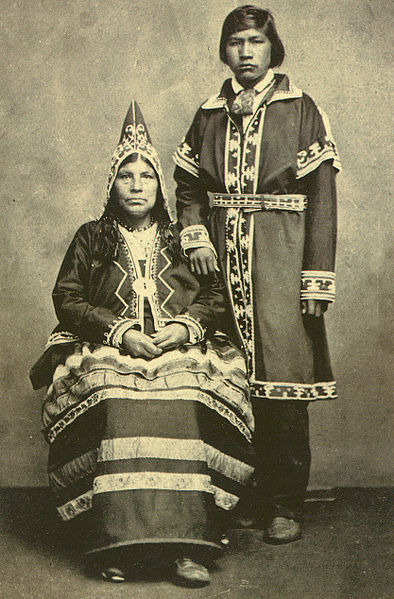 Mi'kmaq men and women would typically wear hides, with men wearing thicker breechcloths and leggings and women wearing lighter tunics and long skirts. While shirts were not mandatory, both sexes would typically wear thicker, warmer robes over their clothing in cold winter months. With more European interaction, European styles of dress were adopted quickly by the Mi'kmaq, though heavily decorated with elaborate beadwork and patterns traditional to the Mi'kmaq. Both men and women would wear headbands with a few feathers sticking up from the band, and would wear their hair long and loose. The traditional beaded, peaked, pointed hat was usually only worn by women. Facepainting was common only in times of war, with men wearing red paint.
By the 1800s CE, it became more fashionable for Mi'kmaq women to braid their hair. At this time it also became more acceptable for Chiefs and others to wear many more feathers, similarly to the war-bonnet of the Sioux. Outside of special occasions such as war, dances, or spiritual events, it was not typical to wear more than a few feathers for decoration.
Mi'kmaq men and women would typically wear hides, with men wearing thicker breechcloths and leggings and women wearing lighter tunics and long skirts. While shirts were not mandatory, both sexes would typically wear thicker, warmer robes over their clothing in cold winter months. With more European interaction, European styles of dress were adopted quickly by the Mi'kmaq, though heavily decorated with elaborate beadwork and patterns traditional to the Mi'kmaq. Both men and women would wear headbands with a few feathers sticking up from the band, and would wear their hair long and loose. The traditional beaded, peaked, pointed hat was usually only worn by women. Facepainting was common only in times of war, with men wearing red paint.
By the 1800s CE, it became more fashionable for Mi'kmaq women to braid their hair. At this time it also became more acceptable for Chiefs and others to wear many more feathers, similarly to the war-bonnet of the Sioux. Outside of special occasions such as war, dances, or spiritual events, it was not typical to wear more than a few feathers for decoration.
Lands:
Mi'kma'ki (lit. "The Nation"), the lands of the Mi'kmaq, traditionally extended throughout the modern day Atlantic Provinces of Canada, the Gaspé Peninsula of Quebec, and the North-Eastern region of Maine. Prior to the Canadian Indian Act, his land was divided into nine districts, each with its own independent governments with a Chief and a council of Elders. These districts were Epekwitk aq Piktuk (Epekwitk aq Pigtug), Eskikewa'kik (Esge'gewa'gi), Kespek (Gespe'gewa'gi), Kespukwitk (Gespugqitig), Siknikt (Signigtewa'gi), Sipekni'katik (Sugapune'gati), Ktaqmuk (Gtaqmag), Unama'kik (Unama'gi), and Taqamgug (Onamag). Archaeologists have accepted that the Mi'kmaq have been active in Nova Scotia for at least four thousand years, with a vast canoe network extending throughout the North-Eastern Atlantic Coast. As the British throughout New England became increasingly aggressive, over six wars were fought by the Mi'kmaq over a seventy-five year period. While the French gave their lands in the 1713 Treaty of Utrecht, the Mi'kmaq were neither a part of the treaty nor accepting to Ceeding land to the British. When the Mi'kmaq complained to the French, they were told that no non-Christian could own land so the point was moot. The Mi'kmaq came to be viewed as members of the Abenaki tribes after the decimation of First Nations peoples in European colonization efforts. The Mi'kmaq officially joined the Wabanaki Confederacy during the 1600s, in the wake of King Philip's War in New England and the first military engagements between the Mi'kmaq and New England forces. The Mi'kmaq continued to hold their lands by force, though their military force was reduced significantly with increasing Acadian and French losses. The British formalized their colonial possession of all the Mi'kmaki in the 1763 Treaty of Paris. The Mi'kmaq continued to maintain they never ceded ownership of their lands, and the Mi'kmaq attempted to play politics and create treaties to hold their lands by British law. The Mi'kmaq were told they must settle their lands, abandon their traditional way of life, and send their children to British schools for assimilation. Military engagements ceased, ending the seventy-five years of continual warfare, with the 1761 Halifax Treaties. There are approximately twenty-seven Mi'kmaq bands in Canada, and one in the United States. Currently, the Mi'kmaq hold the majority of their power within the Canadian island of Nova Scotia. In 1997 the Mi'kmaq-Nova Scotia-Canada Tripartite Forum was formed, establishing an official modern process by which the Canadian Government must formally consult with the Mi'kmaq in Nova Scotia before making any decisions that might impact the tribe, its interests, or its lands. There remain tensions around fishing and other coastal activities, but the sovereignty of the Mi'kmaq in Nova Scotia has greater power than many other First Nations tribes in the Americas, a point of pride for the Mi'kmaq. Many Mi'kmaq volunteered for the Canadian Armed Forces in World War I and World War II, as well as the Korean War. These Mi'kmaq were recognized for distinguished service by the Canadian Government.Economy and Trade:

Mi'kmaq Women Selling Baskets by Mary R McKie
Language:

A sample of Mi'kmaq "hieroglyphic" writing, the Ave Maria. by Christian Kauder
Daily Life:

Mi'kmaw Encampment by Hibbert Binney
Leadership and Divisions:
Families would gather into larger bands, that would appoint a Chief (saqamaw) to oversee group decisions and meet with the Chiefs of other bands; these bands were most likely to interact in the summer when bands moved away from their smaller winter sites and gathered in their larger coastal sites. Traditionally, the group would select a new Chief when the time would come, typically a relative of the previous Chief as children were expected to be mentored by their family into their future professions. In addition to a Chief, who primarily served as a representative delegate outside of the band - such as to other bands, enemies, or when the band would join with others as a larger Confederacy - the band would have a council composed of Shaman, Elder, and other esteemed members of the band. The council and the Chief would set all laws, judgment, and other governmental needs of the band. While traditionally the Chief was a man, in modern day both men and women have served in the role. As of August 30, 2020 the Mi'kmaq of Nova Scotia have had the Mi'kmaq Grand Council (Santé Mawiómi) recognized as the official consultative authority for the Canadian Federal Govnerment, and are the principal government of Nova Scotia. This group was historically composed of specifically selected Chiefs (Keptinaq) of the district councils and served as the traditional senior level of government for all Mi'kmaq. The 1876 Indian Act disrupted any outside recognition of this authority, which reduced their recognition to "spiritual guidance" rather than legal representation or discussion. The leader of the Grand Council, the Grand Chief, was traditionally from the Unamáki band. Men would traditionally be trained to hunt, fight, or go to war while women would remain within the band's territory to forage, craft, tend to children, and prepare food. All Mi'kmaq would take part in storytelling, could become Elders, or Shamans.Clothing:

Mi'kmaq Man and Woman by unknown
Eydraumr:
The Mi'kmaq are not nearly so numerous as the Abenaki, though the Mi'kmaq that remained on the island are highly protective of their lands. It is unheard of for a Mi'kmaw to sell their lands to anyone outside of the tribe, unless those lands were also purchased from outside of the tribe. Both men and women take leadership roles within Eydraumr, with a much more egalitarian split than the Abenaki. Though Eydraumr is technically part of the United States, the Mi'kmaq maintain that the island is an entirely separate entity. The Eydraumr Mi'kmaq have a representative within Santé Mawiómi, Chief Melissa Pictou. The Abenaki have an understanding with the Mi'kmaq within Eydraumr. While on the mainland they could both be said to be Abenaki, the Mi'kmaq of Eydraumr are considered an entirely separate tribe from the Abenaki. The tribes have agreed not to infringe on each other's lands, but the sharing of resources and information is limited and at times strained.Sources:
- Hornborg, Anne-Christine (2008). Mi'kmaq landscapes: from animism to sacred ecology. Vitality of indigenous religions series. Aldershot, England ; Burlington, VT: Ashgate. ISBN 978-0-7546-6371-3.
- Metallic, Emmanuel N; Cyr, Danielle E; Sévigny, Alexandre (2005). The Metallic Mìgmaq-English reference dictionary. Sainte-Foy, Québec: Presses de l'Université Laval/IQRC. ISBN 978-2-7637-8015-3.
- "The use of the terms Mi'kmaq and Mi'kmaw" (PDF). Government of Nova Scotia.
- Johnston, A. J. B. (2013). Niꞌn na L'nu: The Miꞌkmaq of Prince Edward Island. Acorn Press. p. 96.
- Miꞌkmaw Resource Guide, Eastern Woodlands Publishing (1997)
- Weshki-ayaad, Lippert, Gambill (2009). Freelang Ojibwe Dictionary
- Robertson, Marion (2006). Red earth: tales of the Micmac with an introduction to the customs and beliefs of the Micmac (2 ed.). Halifax: Nimbus Publisher. p. 98. ISBN 978-1-55109-575-2.
- Jeddore, John Nick (August 25, 2011). "There were no Indians here ..." TheIndependent.ca.
- Paul, Daniel N. (2000). We Were Not the Savages: A Miꞌkmaq Perspective on the Collision Between European and Native American Civilizations (2nd ed.). Fernwood. ISBN 978-1-55266-039-3.
- "Miꞌkmaq of Nova Scotia, Province of Nova Scotia and Canada Sign Landmark Agreement" (Press release). Indian and Northern Affairs Canada and Government of Nova Scotia - Aboriginal Affairs. August 31, 2010 – via Market Wire.
- Roache, Trina; Moore, Angel (October 18, 2020). "Fisheries conflict: Mi'kmaw Chiefs declare state of emergency". APTN News.
- "Factsheet: The 1999 Supreme Court of Canada Marshall Decision", Fisheries and Oceans Canada, November 20, 2019
- Brasser, T.J. (1978). "Early Indian-European Contacts". In Trigger, Bruce G. (ed.). Handbook of North American Indians. Northeast. 15. Smithsonian Institution Press. pp. 78–88.
- "Archived copy". Archived from the original on 2007-01-25
- Costain, Thomas B. (1954). The White and The Gold. Garden City, New York: Doubleday & Company. p. 54. ISBN 0385045263.
- Lewis, Roger J (February 20, 2006). Pre-contact fish weirs: a case study from southwestern Nova Scotia (PDF) (Thesis). Ottawa: Library and Archives Canada.
- "Kejimkujik National Park and National Historic Site".
- "Roger Lewis". Nova Scotia Museum. April 8, 2013.
- Snow, Dean R. (1978). "Late Prehistory of the East Coast: Nova Scotia, Prince Edward Island, and Eastern New Brunswick Drainages". In Trigger, Bruce G. (ed.). Handbook of North American Indians. Northeast. 15. Smithsonian Institution Press.
- Bernard, Tim; Rosenmeier, Leah Morine; Farrell, Sharon L., eds. (2015). Mi'kmawe'l Tan Teli-kina'muemk Teaching About the Mi'kmaq (PDF). The Mi’kmawey Debert Cultural Centre. p. 106.
- Nicholas, Andrea Bear. "Mascarene's treaty of 1725". University of New Brunswick Library Journals.
- Patterson, Stephen (2009). "Eighteenth-Century Treaties:The Mi'kmaq, Maliseet, and Passamaquoddy Experience" (PDF). Native Studies Review. 18 (1).
- "1752 Peace and Friendship Treaty", Indigenous and Northern Affairs Canada, Government of Canada, Treaty Texts, November 3, 2008,
- Wicken, William C. (2002). Miꞌkmaq Treaties on Trial: History, Land and Donald Marshall Junior. University of Toronto Press. ISBN 978-0-8020-7665-6.
- Patterson, Stephen (2009). "Eighteenth-Century Treaties:The Miꞌkmaq, Maliseet, and Passamaquoddy Experience" (PDF). Native Studies Review. 18 (1).
- Reid, John G.; Conroy, Brenda (2009). Nova Scotia: a pocket history. Halifax: Fernwood Pub. ISBN 978-1-55266-325-7.
- Upton, L.F.S. (1983). "Julien, John". In Halpenny, Francess G (ed.). Dictionary of Canadian Biography. V (1801–1820) (online ed.). University of Toronto Press.
- Cave, Beverley (September 2005). The Petroglyphs of Kejimkujik National Park, Nova Scotia: A Fresh Perspective on their Physical and Cultural Contexts (PDF). Memorial University (Thesis).
- Whitehead, Ruth Holmes; Dennis, Clara; Lonecloud, Jerry (2002). Tracking Doctor Lonecloud: showman to legend keeper. Fredericton, N.B. : Halifax, N.S: Goose Lane Editions via Nova Scotia Museum. ISBN 978-0-86492-356-1.
- Dubé, Alexandre (2003). Tradition, Change and Survival: Mi'kmaq Tourist Art. McCord Museum.
- Kauder, Christian (1866). Buch das Gut, enthaltened den Katechismus. Wien [Vienna: Die Kaiserliche wie auch Königliche Buchdruckerei hat es gedruckt.
- Schmidt, = David L.; Marshall, Murdena (1995). Mi'kmaq hieroglyphic prayers: readings in North America's first indigenous script. Halifax, Nova Scotia: Nimbus Pub. ISBN 978-1-55109-069-6.
- "Mi'kmaq Spirit Home Page". www.muiniskw.org.
- "Miꞌkmaq of Nova Scotia, Province of Nova Scotia and Canada Sign Landmark Agreement" (Press release). Indian and Northern Affairs Canada and Government of Nova Scotia - Aboriginal Affairs. August 31, 2010 – via Market Wire.
- http://www.bigorrin.org/mikmaq_kids.htm#:~:text=Due%20to%20their%20alliance%20with,Northeast%20Coast%20area%20including%20Quebec.&text=Today%2C%20most%20Mi'kmaq%20people,Micmacs%20live%20in%20northeastern%20Maine.


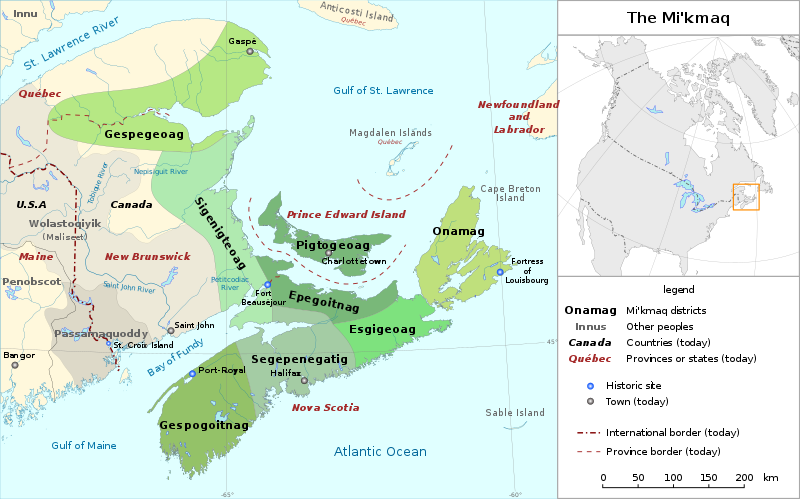
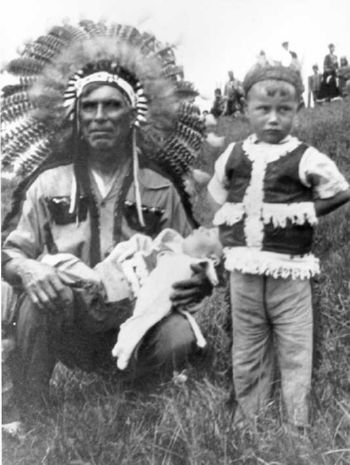


Comments